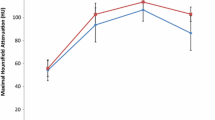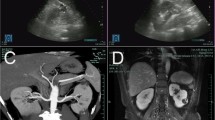Abstract
Purpose
Papillary renal cell carcinoma (P-RCC) typically exhibits a homogeneous, solid hypovascular mass; P-RCC with a cystic appearance is atypical. Tubulocystic RCC (TC-RCC), a newly proposed entity for renal tumors in the 2016 WHO classification, and cystic papillary RCC, may yield similar imaging findings. Therefore, we investigated the incidence of papillary RCC with cystic changes and compared its CT and pathologic features to differentiate between two entities.
Methods
We retrospectively evaluated 26 consecutive patients diagnosed with P-RCC. Two radiologists consensually identified dominant masses indicative of cystic changes on CT scans and recorded their Bosniak classification. In addition, two pathologists inspected the whole area of tumors macroscopically, labeled them as solid- or cystic change-dominant tumors, determined the pathogenesis of the cystic components (necrosis or hemorrhage), and recorded their inherent cystic characteristics (with/without TC-RCC components). We defined masses with cystic changes involving more than 50% of the entire tumor as cystic change-dominant tumors.
Results
Of the 26 tumors, 7 (27%) were diagnosed cystic change-dominant based on imaging and pathologic findings, of these, 2 were classified as Bosniak type III and 5 as Bosniak type IV. The pathologists confirmed that two type IV tumors demonstrated extensive necrosis and one type IV tumor revealed extensive hemorrhage. Four P-RCCs (type III and IV, 2 each) were of a mixed type harboring both solid and cystic components. Only one tumor exhibited a multilocular cystic appearance. All 7 cystic change-dominant P-RCCs were pathologically diagnosed as a pure P-RCC without TC-RCC components.
Conclusion
While P-RCCs may contain cystic features, the multilocular type of cystic P-RCC is rare.



Similar content being viewed by others

Abbreviations
- RCC:
-
Renal cell carcinoma
- P-RCC:
-
Papillary renal cell carcinoma
- TC-RCC:
-
Tubulocystic renal cell carcinoma
- CT:
-
Computed tomography
- CECT:
-
Contrast-enhanced CT
- CM:
-
Contrast medium
- HE:
-
Hematoxylin and eosin
- MRI:
-
Magnetic resonance imaging
- US:
-
Ultrasound
References
Vikram R, Ng CS, Tamboli P, et al. (2009) Papillary renal cell carcinoma: radiologic-pathologic correlation and spectrum of disease. Radiographics 29(3):741–754 (Discussion 755–747). doi:10.1148/rg.293085190
Smith AD, Remer EM, Cox KL, et al. (2012) Bosniak category IIF and III cystic renal lesions: outcomes and associations. Radiology 262(1):152–160. doi:10.1148/radiol.11110888
Brinker DA, Amin MB, de Peralta-Venturina M, et al. (2000) Extensively necrotic cystic renal cell carcinoma: a clinicopathologic study with comparison to other cystic and necrotic renal cancers. Am J Surg Pathol 24(7):988–995
Zhou M, Yang XJ, Lopez JI, et al. (2009) Renal tubulocystic carcinoma is closely related to papillary renal cell carcinoma: implications for pathologic classification. Am J Surg Pathol 33(12):1840–1849. doi:10.1097/PAS.0b013e3181be22d1
Nagashima Y, Kuroda N, Yao M (2013) Transition of organizational category on renal cancer. Jpn J Clin Oncol 43(3):233–242. doi:10.1093/jjco/hyt006
Moch H, Cubilla AL, Humphrey PA, Reuter VE, Ulbright TM (2016) The 2016 WHO classification of tumours of the urinary system and male genital organs-part A: renal, penile, and testicular tumours. Eur Urol 70(1):93–105. doi:10.1016/j.eururo.2016.02.029
Kuroda N, Matsumoto H, Ohe C, et al. (2013) Review of tubulocystic carcinoma of the kidney with focus on clinical and pathobiological aspects. Pol J Pathol 64(4):233–237
Cornelis F, Helenon O, Correas JM, et al. (2015) Tubulocystic renal cell carcinoma: a new radiological entity. Eur Radiol . doi:10.1007/s00330-015-3923-9
Hora M, Urge T, Eret V, et al. (2011) Tubulocystic renal carcinoma: a clinical perspective. World J Urol 29(3):349–354. doi:10.1007/s00345-010-0614-7
Maeda Y, Goto K, Honda Y, et al. (2016) A case of tubulocystic carcinoma of the kidney with aggressive features. Jpn J Radiol 34(4):307–311. doi:10.1007/s11604-016-0525-7
Yang XJ, Zhou M, Hes O, et al. (2008) Tubulocystic carcinoma of the kidney: clinicopathologic and molecular characterization. Am J Surg Pathol 32(2):177–187. doi:10.1097/PAS.0b013e318150df1d
Egbert ND, Caoili EM, Cohan RH, et al. (2013) Differentiation of papillary renal cell carcinoma subtypes on CT and MRI. AJR 201(2):347–355. doi:10.2214/ajr.12.9451
Wood CG 3rd, Stromberg LJ 3rd, Harmath CB, et al. (2015) CT and MR imaging for evaluation of cystic renal lesions and diseases. Radiographics 35(1):125–141. doi:10.1148/rg.351130016
Dilauro M, Quon M, McInnes MD, et al. (2016) Comparison of contrast-enhanced multiphase renal protocol CT versus MRI for diagnosis of papillary renal cell carcinoma. AJR 206(2):319–325. doi:10.2214/ajr.15.14932
Israel GM, Hindman N, Bosniak MA (2004) Evaluation of cystic renal masses: comparison of CT and MR imaging by using the Bosniak classification system. Radiology 231(2):365–371. doi:10.1148/radiol.2312031025
Chen Y, Wu N, Xue T, Hao Y, Dai J (2014) Comparison of contrast-enhanced sonography with MRI in the diagnosis of complex cystic renal masses. J Clin Ultrasound . doi:10.1002/jcu.22232
Kim S, Jain M, Harris AB, et al. (2009) T1 hyperintense renal lesions: characterization with diffusion-weighted MR imaging versus contrast-enhanced MR imaging. Radiology 251(3):796–807. doi:10.1148/radiol.2513080724
Akita H, Jinzaki M, Akita A, et al. (2014) Renal cell carcinoma in patients with acquired cystic disease of the kidney: assessment using a combination of T2-weighted, diffusion-weighted, and chemical-shift MRI without the use of contrast material. J Magn Reson Imaging 39(4):924–930. doi:10.1002/jmri.24226
Xing W, He X, Kassir MA, et al. (2013) Evaluating hemorrhage in renal cell carcinoma using susceptibility weighted imaging. PLoS ONE 8(2):e57691. doi:10.1371/journal.pone.0057691
Amin MB, MacLennan GT, Gupta R, et al. (2009) Tubulocystic carcinoma of the kidney: clinicopathologic analysis of 31 cases of a distinctive rare subtype of renal cell carcinoma. Am J Surg Pathol 33(3):384–392. doi:10.1097/PAS.0b013e3181872d3f
Tran T, Jones CL, Williamson SR, et al. (2016) Tubulocystic renal cell carcinoma is an entity that is immunohistochemically and genetically distinct from papillary renal cell carcinoma. Histopathology 68(6):850–857. doi:10.1111/his.12840
Acknowledgements
We would like to thank Editage (www.editage) for English language editing.
Author information
Authors and Affiliations
Corresponding author
Ethics declarations
Funding
No funding was received for this study.
Conflict of interest
The authors declare that they have no conflict of interest.
Ethical approval
All procedures performed in studies involving human participants were in accordance with the ethical standards of the institutional and/or national research committee and with the 1964 Helsinki declaration and its later amendments or comparable ethical standards.
Informed consent
Informed consent from all individual participants included in this retrospective study was waived by the institutional review board.
Rights and permissions
About this article
Cite this article
Honda, Y., Goto, K., Nakamura, Y. et al. Imaging features of papillary renal cell carcinoma with cystic change-dominant appearance in the era of the 2016 WHO classification. Abdom Radiol 42, 1850–1856 (2017). https://doi.org/10.1007/s00261-017-1189-1
Published:
Issue Date:
DOI: https://doi.org/10.1007/s00261-017-1189-1



